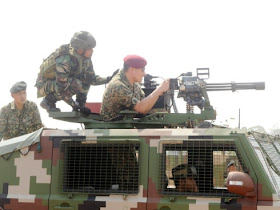4 December 2022 update:
Pukul Habis: Available from Amazon sites that serve your location. "Look Inside" function on some sites shows sample pages.
Singapore: https://bit.ly/3XJzInH
Australia: https://amzn.to/3ViaX0i
Canada: https://amzn.to/3VkjqQP Look Inside
France: https://amzn.to/3uenBS5 Look Inside
Germany: https://amzn.to/3XLcJc0 Look Inside
Japan: https://amzn.to/3gS2Loz Look Inside
Spain: https://amzn.to/3OSfi7S
Sweden: https://bit.ly/3GWq7UI
United Kingdom: https://amzn.to/3EZ6clA Look Inside
USA: https://amzn.to/3Ui3Eo1 Look Inside
So if the Infantry doesn't move, the Army doesn't move either?
The logic is disarmingly simple (excuse the pun). But how does one stop an intruder's infantry or keep it in check?
Look no further than the Malaysian Army should you need an example of how the tempo of an infantry attack could be blunted.
Malaysia is quietly strengthening the sharp end of her infantry units to deal with an intruder's armour and mechanised infantry. This is especially so when one considers the introduction of miniguns to the Malaysian Army's armoury.
Condor APC with Dillon Aero M134D minigun and gunshield.
Lipanbara MRAP with Dillon Aero M134D minigun.
War machines such as the Condor APC and Lipanbara MRAP have been displayed with six-barrel miniguns that fire 50 7.62mm rounds every second, accurate up to 1,200m. That's more than four times the rate of fire compared to a General Purpose Machine Gun (GPMG).
And the effective range of minigun fire is more than adequate for the average engagement distance estimated for firefights between land forces on peninsular Malaysia.
The "anti invasion" capability of the Malaysian Army is correspondingly increased because the weight of fire and accuracy of Malaysian infantry is substantially enhanced, thanks to the miniguns. When augmented by 40mm automatic grenade launchers and RPGs fielded as anti-infantry weapons, such firepower is
Whether in an ambush, meeting engagement, deliberate attack or block force operations, the amount of firepower Malaysian infantry can deliver in a shootout could potentially rattle soldiers coming under fire for the first time.
It is important not to overlook the psychological effect of a first clash that provokes a fierce reaction against an intruder's soldiers. The minigun is thus a misnomer as there is certainly nothing "mini" about the deluge of aimed, sustained, automatic fire minigun operators can bring to bear against their target.
Malaysian defence planners probably reasoned that when its infantry is sent into operations against an intruder who controls the skies, and one with an advantage in armoured platforms and guided munitions, Malaysian infantry must have what it takes to deliver the heaviest possible firepower when targets are in sight and within range.
Engagement windows may also be small. This is possibly due to the need for Malaysian assets to redeploy quickly to a new firing position soon after opening fire, or risk being engaged in place by superior firepower. During that small and time-limited engagement window, Malaysian infantry must deliver the deadliest fire possible before the unit disengages to deploy to a new firing position.
Miniguns have helped Malaysia close the firepower deficit. But this is achieved on the assumption that the Malaysian Army's logistics train is able to continually resupply frontline units with ammunition.
Here's the tradeoff: At 3,000 rounds per minute, a minigun must be liberally - or at the very least, regularly - supplied to ensure its fighting effectiveness. This is because on-board ammo is limited, and rationing the amount of fire unleashed would in effect compromise any benefits of a weapon with a high rate of fire. The supply push is therefore critical for maintaining the operational effectiveness of minigun-armed assets.
It is thus up to Kor Ordnans Diraja units to weather the storm and address the demand of units on the frontline.



This is a very silly purchase. Such high rate of fire weapons are only relevant in air to air engagements which really are time limited enough for this to matter. Otherwise all this does is waste ammunition and strain logistics for no good reason. You don't get better suppression or killing power. If something can be done with 1 bullet, firing 5 is just a waste. This is pure form over substance.
ReplyDeleteNono. Volume of fire is still a critical component of warfare. Miniguns are proven weapons for vehicles - but in the main for convoy protection from infantry ambush.
ReplyDeleteThe US Army perfected the Mad Minute during the Vietnam War when each individual convoy escort vehicle (gun truck or M-113 ACAV) took on a sector as counter ambush drill - providing beaten zones of fire to suppress enemy infantry while the rest of the convoy ‘Gets out of Dodge’. n they have been used successfully more recently in Afghanistan.
The number of swivel mount GPMGs mounted on Singapore Army M-113 and Air Force V-200 back in the 1980s shows that part of this doctrine was understood and used by the RSAF.
Apart from ammunition use, the negative aspect of the M-134 is that it’s 7.62mm (not 7.7 - that’s a WW2 Japanese right calibre) rounds aren’t going to do much against even a light armoured opponent - especially one that replies in 12.7mm BMG, 14.2mm or greater.
Against insurgents that the Royal Malaysian Army has and will continue to face in Sawarak, etc these vehicles are fit to fight. Against an organised military opfor their utility simply isn’t there - lack of penetration plus rapid ammunition use can’t be justified.